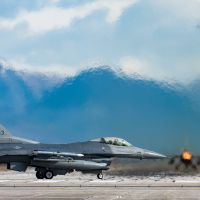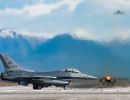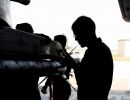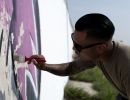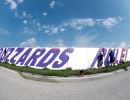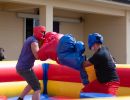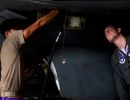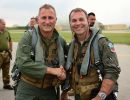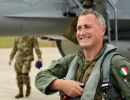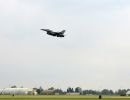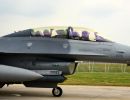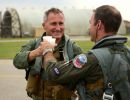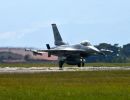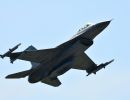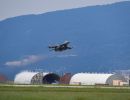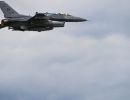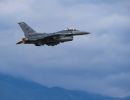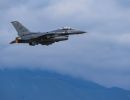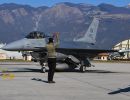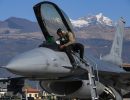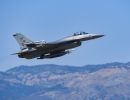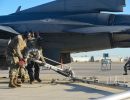It was a four part program. Pre-flight, primary flight training, basic flight training, and advanced flight training. In primary we flew PT-19s (PT-Primary Trainer-etc.), in basic we flew BT-13s (the Vultee Vibrator), and finally in advanced we flew the AT-6 Texan. The entire program required about nine months.
Dual flight training causes a flight instructor, riding in the back seat of a trainer, to lapse into illogical and unpredictable rages. There is something about being in the back seat of a trainer and looking at the back of the head of a dumb, blockhead student pilot who is ignoring drift or heading away from the field with a clear signal in the headsets that makes it completely obvious that that he is flying a reciprocal heading, that causes a normal, considerate male to rage and scream in memorable ways. Hap and I put up with this throughout flight training.
Then there was the Cadet Blue Book. We had to read and memorize the Cadet Blue Book. The most important part of the Blue Book was a paragraph that defined the three acceptable answers to a question from an officer. The three acceptable answers were: Yes sir, No sir, and No excuse sir. Any other answer was considered quibbling, a washout offense. The Blue Book also instructed us to come to attention when an officer addressed us, and to stay at attention until the officer told us to stand at ease, or be at ease, two carefully defined situations.
Training was divided into a half day of physical training (including military drill), and a half day of school or flight training.
In Pre-flight we were marched into the mess hall and remained standing at attention, behind our stools until we were given the command to-TAKE SEATS! Our seats were metal stools and if we made too much noise picking our seats up off the cement floor and sitting on them, we would be told that the noise we made was unacceptable, and would be commanded to come back to attention and commanded to TAKE SEATS again, sometimes this would be repeated several times.
We had to eat while sitting on the first three inches of our metal stools. We could not talk except to ask that food be passed. We could not look up from our plates, except when we asked for food to be passed. Our left hand had to be in our lap except when we had to use our knife to cut food. The utensils that we were not actively using had to be placed on the top of our plates facing from four to ten o'clock, knife, fork, and spoon in that order, with the knife blade in, not out.
When we got to primary training and ate in a dining hall with normal protocol, it seemed almost sinfully casual.
This preamble may give you some idea of the problem that Hap and I had when we were commissioned on the 20 of March, 1943 and moved from the cadet barracks to the Bachelors Officer Quarters at Foster Field, Texas. We were not officers. We were cadets transitioning into the officer class and that takes a finite amount of time.
The afternoon of March 20, 1943 the day we got our commissions and our silver wings, is the day that I decided that Hap Miller was a good guy. I hardly knew him when we were cadets. We were in different flights and different barracks but on the day we were commissioned as second lieutenants we came together.
The Navy has a term for new lieutenants (ensigns). They call them Nuggets. Beautiful, shiny, eager, and dumber than a base metal.
Hap and I carried our gear from the cadet barracks and were assigned rooms in the BOQ at Foster Field on the day we were commissioned, and probably got there about four in the afternoon. We had spent the early part of the day getting our wings, going through the commissioning ceremony, and waiting for our orders.
In the first hour after we moved into our rooms in the Foster Field BOQ Hap Miller revealed himself to me as human, sensitive, and vulnerable. I still vividly remember that first encounter.
He came to my room in the BOQ after we were settled in, and at about at the same time the dining room was scheduled to open in the Officers Club. We began talking about the days activities, our cadet experiences, and what our assignment might be. It became evident to me that Hap was drawing this conversation out because he was afraid to go into the Officers Mess. So was I. That was the beginning of our friendship.
Finally, just a few minutes before the Officers Mess was scheduled to close, and was therefore was nearly empty, we went to eat. We were starved.
Let me be candid. We were not Pollyannas. Hap and I smoked, we drank, and we liked girls-especially girls that believed in recreational sex. We were irreverent, we used obscenities. By the standards of that era we may have stretched the envelope at times but on the other side of the coin we were honest, we were completely identified with what we were doing, and we were balls to the wall fighter pilots. If you did not like our style-too bad.
A few days after graduation we were assigned to Matagorda Peninsula a satellite base under Foster Field as tow target pilots. On the peninsula we worked seven days a week, flew many hours, and became solid pilots.
After Hap and I began towing targets in the B-34 on Matagorda Peninsula we were caught out on a mission towing targets when, what the Texans call a Blue Norther (cold front), came through. Belatedly, the ongoing missions were cancelled and everyone was ordered back to the base. Chaos reigned. About fifty or so airplanes, a dangerous mix of trainers, fighters, and bombers, had to land on the peninsulas 4000 foot runway in the ten to twenty minutes before the storm arrived, with heavy rain and low clouds, and make it very difficult to find the field and get safely on the ground.
I was close in when the recall was announced and made it back easily. Hap was farther away from the base, and by the time he was on final approach, I was in the ready room having a cup of coffee, looking out the window at the rain, and grateful for being there. Hap was the last to land.
When he was on final approach the the front edge of the cold front went through and we had a total wind reversal in just a few seconds. From the ready room, I saw the wind sock reverse directions and the heavy rain begin, while Hap was on final approach. With the wind reversal he was now landing down wind on the wrong runway. His touchdown speed, with the tail wind, would be over 120 knots, more that 40 knots higher than our no wind touchdown speed. There was an alternative. He could pull up, go around and land in the other direction. He would then risk not finding the field in the heavy rain and low visibility. He chose to land.
The B-34 was a high performance twin engine airplane with two R-2800, two thousand horsepower engines. It was not designed to land downwind on a short runway at 120 knots, so there was some real doubt that Hap could get the airplane stopped before he ran out of runway. The picture of him touching down is still in my mind like a photo. The landing speed was so hot that he touched down past the first third of the runway with about 2500 feet of runway remaining. I remember thinking, "Oh boy, this is going to be close." Immediately after the airplane touched down, the brakes began to scream and smoke poured off the tires. He got the airplane stopped before he ran out of runway-barely.
When he came into the ready room his flying suit was soaked with sweat,
his face was glistening with sweat, and he had a stub of a dead cigar
clenched in his teeth.
I was ready for him. "What was all that about? Why are you so hot? I didn't have any trouble landing. Why were your brakes screaming? Why was all that smoke coming off the tires?"
Hap was was still on a step. He went right to the mat with me. As I recall he said, "Because, you dumb son of a bitch, I landed the god dammed airplane downwind, at about a million miles an hour. That's why the brakes were screaming and the tires were smoking. That's why I'm hot. OK?"
Got him.
Our mission on the peninsula was to train Fighter Gunnery Instructors. Seasoned fighter pilots, many of whom had flown combat tours in Europe or the far east, were sent to the school. Some of our students were Aces. The training was split between classroom and flying training. After completing training on the peninsula our students went back to their units set up, and conducted, fighter gunnery courses patterned after the course on the peninsula.
Hap and I towed targets for the trainees. The targets were 6x20 foot screen wire mesh mounted behind a weighted iron bar. Connected to the tow plane by a cable, the weighted bar held the target in a vertical position, about two hundred feet behind the tow plane. The students were given gunnery training in AT-6s and in the fighter that they were flying in their home units. We had about four each of all the types of fighters in use by the Air Corps during WW11, assigned to the peninsula. These were the P-38, P-39, P-40, P-47, and P-51.
During the first half of the year that we were on Matagorda we towed targets in AT-6s for AT-6 gunnery training. After we gained experience we were checked out in, and then towed targets in, B-34s for students flying fighters. The B-34 was a powerful, high performance twin engine airplane that would tow a target at speeds that the fighter gunnery trainees would encounter in combat.
Classes lasted a month. Between classes we had a break for a few days and would take off, usually for Houston. We always stayed at the Texas State Hotel in downtown Houston. What did we do? Just bummed around, ate in restaurants, saw the sites, looked for girls, and went to any events of interest in Houston.
Once we went to a Southwest Conference football game and watched Rice University play another Texas team. Being a Big Ten fan Hap bad mouthed the quality of football that we saw that day. Since I am from Louisiana, Southwest Conference football was down home for me. I was making excuses for the poor quality of the play, there was a war on and so forth, until I caught a glimpse of Hap's gotcha smile.
To get to Houston we would get someone to fly us to Foster Field at Victoria, Texas and take a train to Houston. I don't remember how we got around on the ground in Houston, probably by cab.Once on the trip back from Houston Hap shared a seat on the train with a comely Texas girl. The coach of the train was dark so during that trip they became very well acquainted, before she got off the train at a town east of Victoria.
A few days after we got back to the peninsula Hap got a letter from this girl, which he showed me or read to me. In the letter she made it very clear that their next encounter would be a sexual encounter. During the two or three weeks before the next break in classes Hap was in the grip of a testosterone frenzy. When the break in classes finally arrived (it must have seemed like months to him) he went through the mach getting to the girls home town.
He came back in a few days smiling, sated, and at peace with the world. He was discreet, and never did get specific about what had occurred, but I was confident that he had conducted himself in accordance with the fighter pilot's creed.
There were two twin engine trainers assigned to the peninsula that were to be used for administrative flights. One was an AT-9. I will not try to describe the AT-9 except to say that it was one sorry airplane. It had nearly the same speed for take off, climb, cruise, let down, and landing. In addition to being slow and ugly it was also dangerous and difficult to fly.
For reasons that I never really understood, but possibly just to leave me in a state of perpetual conjecture, Hap learned to fly the AT-9 and began to fly it on trips, usually with passengers, to Foster Field. I rode co-pilot with him once, repeat once, in that thing. After we got on the ground I told him that if he liked to fly that sorry piece of junk, as far as I was concerned, he needed a saliva test. He gave me his gotcha smile.
The pilots seat in the AT-9 was on metal runners so the pilot could adjust the seat forward and back for his height and leg reach. There were pin holes in the metal runners, and some care had to be used to insure that the pins on the seat were in the holes, or the seat would not be secure. In addition if the pins became worn the seat would slide forward or back at unpredictable times.
Hap was flying our supply officer someplace when the pins on the pilots seat jumped out of the holes in the metal runners as the throttles were opened for take off. As the airplane accelerated on the runway, the pins came out of the holes and the pilots seat slid to the back end of the runners. Hap could not reach the controls. Fortunately as he slid back he pulled the throttles back to the idle position. Still, the airplane was going about forty miles an hour on the runway with no one at the controls. Hap began yelling at the supply officer, who was in the copilots seat, to get on the rudders and hold the airplane straight. To no avail. The airplane ran off the runway and, by the time Hap got back into position to control it, had done a slow ground loop and raised a hugh cloud of dust in the area between the runways. No one was hurt, the airplane was not damaged, but Hap's ego was wounded. I told him for the hundredth time that he was crazy to fly that ridiculous suicide machine and he gave me his gotcha smile for the hundredth time.
In about March 1943 we got orders assigning us to a replacement training unit in Richmond, Virginia. There we went through a transition training program in the P-47, Thunderbolt, a complex, powerful, heavily armed flying machine. From Richmond we were assigned to a unit at the Norfolk, Virginia airport and went through gunnery training. After our experience with fighter gunnery on Matagorda Peninsula, Hap and I easily qualified as expert aerial gunners. Norfolk was our last stop before going overseas.
Occasionally we would be called in to the personnel section and a personnel clerk would go over our records with us. This was done when we were at Norfolk. It was during this records check that Hap was told that he could be excused from combat, and stay at Norfolk as a gunnery instructor. Since he was the oldest child of a widow with other children, and was providing for their support, he only had to request to be excused from combat, and that would happen.
He asked me what I thought he should do and I told him that the decision was too personal for me to offer an opinion. He chose to not make the request. It was a fateful decision.
Hap went home on leave before we left Norfolk, in about June of 1944. When he returned he was different. Somehow, getting in touch with his roots had made him more reflective. He also had made a resolution to never have more than three drinks in one evening, and he kept that resolution. I was disappointed, he was a good drinking buddy.
After Norfolk we went overseas on the Aquitania, a sister ship of the Lusitania. When we arrived in Scotland we were assigned to an overseas training base at Shrewsberry, England.
While we were flying out of Shrewsberry, Hap got into a flat spin in a P-47. A flat spin is unusual and it is also a deadly, dangerous condition. The airplane stalls, usually at the top of a loop or Immelmann and starts to fall in a flat position with zero air speed. Most of the time it is a bail out situation or worse.
Hap got into a zero airspeed situation on the top of a loop and the airplane began to fall straight down, in level flight attitude at zero air speed. Fortunately he was at a nominal altitude for practicing aerobatics in the P-47, probably above 10 thousand feet.
At zero air speed the controls have no effect on the attitude of the airplane because the is no air going over the foils horizontally and no lift being generated. Hap fought the controls, changed power settings, finally got the nose down, picked up some air speed, and flew the airplane out of the flat spin. That was another situation wherein he came into the ready room after the flight with a cigar clenched in his teeth and covered with sweat. I did not try to work him over that time.
Seventy five of us replacement pilots were assigned to Shrewsberry in that training class. We were given a briefing by a senior officer the first day after we arrived. This gent told us that this was to be our final phase of training before going into combat so when we went up on a training mission he wanted us do aerobatics, get in dogfights, and try to take the wings off the airplane. That is a quote.
We were there for three weeks in training. In that three weeks thirteen of the seventy five were killed in flying accidents.
When we completed our training at Shrewsberry we were asked if we wanted to be assigned to the Eighth or Ninth Air Force. The Eighth Air Force flew out of England and the Ninth Air Force flew from bases in France. The eighth was considered the glamour air force since they flew mostly escort missions and saw a lot of aerial combat. The ninth, by comparison, flew close support bombing and strafing missions and was considered an inferior assignment. Hap and I both volunteered to go to the eighth but there were more volunteers for the eighth than vacancies, so the personnel types put the names of the volunteers in a hat and drew names until the quota for the eighth was filled. My name was drawn, Haps' was not. I really wanted to go to the eighth but when I looked across the room at Hap, he was giving me-the look-so I asked that my name be taken off the eighth list and someone else substituted. So we stayed together one more time.
After overseas training at Shrewsberry we were assigned to a Repple Depple (Redeployment Depot) in Paris, a military tent city. The second day that we were there Hap and I went into downtown Paris on a languid sight seeing trip. When we returned to camp we were told that the assignments had been given out. We rushed to the personnel tent and asked if there was still an outfit with two vacancies. The answer was yes, the 510th at St. Dizier, France had asked for five replacements, and two openings remained. We said, put us on that list.
We went back to our tent and told the guys that we were going to the 510th. Someone said, "Didn't you wonder why they still had two openings." We said, "What are you trying to tell us?" The answer given was that the 510th had a reputation for high losses, hence the need for a lot of replacements. That reputation was deserved. The entire group which consisted of three squadrons, 509th, 510th, and 511th, was staffed by an aggressive, motivated bunch of professionals who took the war to the enemy. They had high losses, but they shortened the war, and thereby saved a lot of lives-on both sides.
We began to call ourselves Jenkins Jerry Junkers. Ralph Jenkins was one of four squadron commanders leading the squadron during the time the unit was in combat. Ralph was the only one that was not shot down. Ralph now lives in Seattle, Washington and is hosting our 1984 reunion. This reunion will be special. We will have near 100% attendance.
The 510th flew close support bombing and strafing missions. On a typical mission each P-47 would carry two composition B 500 pound bombs, one under each wing, a cluster of twelve thirty pound fragmentation bombs under the belly, and four hundred rounds of fifty caliber ammunition for each of eight machine guns, four in each wing. Armed this way the Thunderbolt lived up to its name. It was an extremely powerful offensive weapon.
On each mission we followed the same general scenario. First we found targets for our bombs and lightened our total weight, then we looked for strafing targets. The armorers put five rounds of tracer in our ammunition belts a hundred rounds from the end of the four hundred round belt in each gun. When we saw tracer we knew we had a hundred rounds remaining in each of the eight guns. I was not unusual for us to return home with a hundred rounds of ammunition, or less, in each gun. We always tried to keep one hundred rounds in each gun in case we were jumped by enemy aircraft on the way home. Sometimes, however, there would be so many targets that we would keep strafing until our guns were empty.
Since we controlled such a powerful offensive weapon we wreaked havoc on the German forces. On two missions, both flown on the same day in early 1945, the 510th destroyed 49 locomotives in the Ruhr Valley. We made headlines in the European newspapers the following day.
We had high losses. We lost some airplanes in dogfights but most of our losses were to flak. The Germans had three flak gun models. The 88 (millimeter), the forty, and the twenty. All fired explosive shells. Occasionally one of us would be hit by 88s but we moved too much for them to be a big threat. When looking for targets we flew at a nominal altitude of ten thousand feet. At this altitude we were a target for the 88s but, we varied our heading and altidude in a random pattern that we called jinxing. This made us an elusive target for the 88s, but the 88s did get a few of us.
Forty and twenty millimeter flak, our main concern, self destructed five thousand feet from the firing point. Otherwise the the projectiles would explode when they fell back to the ground. Therefore, as long as we stayed above five thousand feet we were out of range of the 40s and the 20s. However, when we bombed or strafed we had to go below five thousand feet (way below like-to ten feet above the ground) and nearly always drew fire from the 40s and 20s. The 40s and 20s had very high firing rates, close to machine gun rates, and we had to fly through these streams of fire to reach our targets. There was some skill involved, but surviving depended mostly on luck.
Our chances of surviving a combat tour without being shot down were far less than fifty percent. There was an element of luck involved here too. Many of us (most of us would be a more accurate statement) were shot down. In many instsnces we were able to get back across the bomb line and belly in or bail out. We all, repeat all, were hit by ground fire. Where we were hit, and how we were hit, determined whether we were killed, became a prisoner of war, or made it back across the bomb line to bail out, belly in, or limp back to the base and fly yet another mission.
After we were settled into the 510th Hap flew his first mission before I did. I went to the mission debriefing and followed Hap around until we had a private moment together. He talked in a different way. Stripped of pretense, free of the persona that he, and the rest of us try to project, he said that he had been very frightened during the mission and that he had made a mistake in choosing to go into combat. There it was, his bare unprotected soul, his fear, shamelessly expressed. I do not remember what I said, but I understood.
Hap and I were in different divisions and never flew a mission together. When the planes returned from the third mission that Hap flew, he was missing. The mission debriefing, which Pete Haring our intelligence officer usually conducted masterfully, was chaotic. Several times I asked, "Where is Miller?" The squadron leader, Captain Nonnemacher, was stressed out. He wanted to talk about other aspects of the mission because the squadron had run into enemy aircraft. In the ensuing dog fight one German airplane was shot down, and the focus of the mission had been lost in the resulting confusion.
After several unsuccessful tries I asked again, "Where is Miller?" One of the members of the flight sensing my very real concern, took me aside, and quietly said that after the dog fight the squadron had deployed to find strafing targets. Miller found a target and, when he began his pass on the target, his right wing was blown off by flak. "He hit the ground at dive speed," this pilot said, "There is no way he could have survived."
Five of us had been assigned to the 510th together as replacements. We lived in a winterized tent, in the squadron area, on the airport at St. Dizier, France. Clockwise from the door there was Herschel Ponder, Stuart Wilde, Hugh Miller, Clifford Mayer, and Gene Johns. That night Millers' bunk was empty. It was just that simple. It was just that stark.
No more Miller. No more Hap.
One concluding thought. To his family and to me Hap will be forever young.
M. Eugene Johns
Epilogue: At one of the early reunions of the 510th I learned that Hap had survived the crash. I was very distraught. It was much easier for me to accept his death when I thought he had died instantly.


